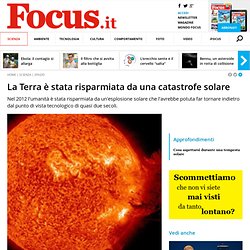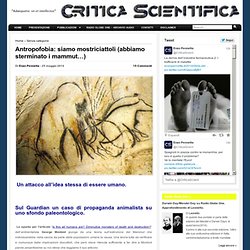

Global Warming: un problema reale, da non sottovalutare. AMBIENTE – È abbastanza comune, alla fine dell’estate, che influencer più o meno noti della rete (non necessariamente facenti parte dell’ambiente scientifico, tuttavia ascoltati da un ampio pubblico), si mettano a dibattere del tema del riscaldamento globale sulla base di dati piuttosto ininfluenti, quali le temperature stagionali più o meno vicine alle medie, così come viene spesso presa a riferimento l’abbondanza delle piogge senza usare la statistica né adottare una visione più allargata del problema rispetto al proprio campetto.

Prepararsi alla supertempesta solare prossima ventura. Una tempesta solare particolarmente intensa potrebbe mettere in ginocchio i sistemi di comunicazione, trasporto e fornitura di energia elettrica, tutte infrastrutture cruciali per la nostra società.

Dato che l'ultimo "evento Carrington", come sono chiamate dagli addetti ai lavori questo tipo di tempeste, risale al 1859 e che si stima che si verifichino in media ogni 150 anni, un gruppo di ricercatori lancia un appello perché vengano prese misure che possano mitigarne i potenziali effetti (red) La domanda non è se, ma quando.
Quando, cioè, si verificherà una tempesta solare in grado di interferire pesantemente con le infrastrutture di comunicazione ed energetiche della Terra. Geomagnetic storm. Artist's depiction of solar wind particles interacting with Earth's magnetosphere.

Sizes are not to scale. A geomagnetic storm is a temporary disturbance of the Earth's magnetosphere caused by a solar wind shock wave and/or cloud of magnetic field which interacts with the Earth's magnetic field. The increase in the solar wind pressure initially compresses the magnetosphere and the solar wind's magnetic field interacts with the Earth’s magnetic field and transfers an increased energy into the magnetosphere. Both interactions cause an increase in movement of plasma through the magnetosphere (driven by increased electric fields inside the magnetosphere) and an increase in electric current in the magnetosphere and ionosphere.
During the main phase of a geomagnetic storm, electric current in the magnetosphere creates a magnetic force which pushes out the boundary between the magnetosphere and the solar wind. History[edit] Definition of a geomagnetic storm[edit] Historical occurrences[edit] “Una tempesta solare ci spegnerà” La Terra è stata risparmiata da una catastrofe solare - Focus.it.
Era il 2012 quando il Sole produsse un'esplosione tale che se avesse colpito la Terra avrebbe riportato la nostra società indietro di un secolo.

Un simile evento non si è mai verificato sul Sole da almeno 150 anni a questa parte. Lo ha recentemente affermato la US space agency. Un'altra super-tempesta solare è inevitabile: l'appello dei ricercatori ai Governi. Earth's Electromagnetic Field Is Weakening. The Earth's magnetic field, which protects us from radiation from space, is getting weaker.

We don't yet know why this is, but new evidence confirms it is happening unevenly across the planet with some areas getting more protection. Evidence of weakening of the magnetic field, and it's geographically inconsistent nature, has been tracked for decades, but the November 2013 launch of the European Space Agency's three satellite Swarm constellation has allowed unprecedented precision in measuring these changes.
The field is a result of the Earth's iron core acting as a giant magnet. However, the core is not stable, with the magnetic north and south poles wandering around at rates of around 15 km/year for most of last century, and recently accelerating. Over periods of millions of years the poles sometimes switch places, and there is some speculation that such a switch is coming soon. The north magnetic pole is currently moving towards Siberia from its location in Canada. New Study Suggests The World Is On The Brink Of The Next Great Extinction. Just as we all die, all species eventually go extinct.

However, the rate of extinction varies dramatically, and a new estimate suggests we are currently running at 1000 times the normal rate. This rate of extinction is only seen in the fossil record after incredibly dramatic and unusual occurrences, such as huge asteroid strikes or supervolcano eruptions. In order to calculate the effect humans are having we need to know two things – how many species are disappearing each year, and how many vanish as part of the normal background. Humans, Not Climate Change, To Blame For Ice Age Animal Extinction.
Our last glacial period lasted from about 115,000-12,500 years ago.

By the end, 177 large mammal species had gone extinct. There has been considerable debate over the last half century regarding what caused the loss of these animals, including saber-tooth cats, mastadons, and giant sloths. While many have argued that these animals simply weren’t able to adapt to the warmer climate, others blame human activity. A new study led by Jens-Christian Svenning of Aarhus University has strongly suggested that humans are squarely responsible for the disappearance of megafauna during the last 100,000 years.
The results have been published in the Proceedings of the Royal Society B. For this study, the researchers focused on megafauna, which is categorized as animals weighing at least 10 kg (22 lbs) that lived in the last 132,000 years. Antropofobia: siamo mostriciattoli (abbiamo sterminato i mammut…) Un attacco all’idea stessa di essere umano.

Sul Guardian un caso di propaganda animalista su uno sfondo paleontologico. Watch "Beast" Asteroid Pass By Earth Live. On June 8, asteroid 2014 HQ124 will pass by Earth at three times the distance of the moon.

It poses no risk of hitting us. Good thing, because it's 352 meters (1,100 feet) long! Researchers at NASA’s Wide-Field Infrared Survey Explorer (WISE) first detected the behemoth on April 23.